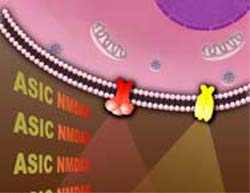

In the neural train wreck that is stroke, the cutoff of oxygen kills brain cells through a buildup of acid, as well as by overexciting receptors on the surface of brain cells. Now, researchers exploring the detailed mechanism of this excitotoxicity and acidotoxicity have discovered how an insidious chain of molecular events contributes to its damage. In an article in the Nov. 23 issue of Neuron, CAS researchers say that their findings could contribute to the development of drugs to protect against the molecular "cabal" that produces such lethality.
The researchers include GAO Jun, DUAN Bo, WANG De-Guang and XU Tian-Le from the Institute of Neurosciences, the CAS Shanghai Institutes for Biological Sciences; DENG Xiao-Hong and XU Lin Xu from the CAS Kunming Institute of Zoology; ZHANG Guang-Yi from the Xuzhou Medical College in Xuzhou.
In their experiments, the researchers discovered the molecular mechanism linking two key components of neuronal damage due to oxygen starvation, or ischemia. One component is a type of receptor called an NMDA receptor (NMDAR). This receptor is triggered by glutamate, which is known to be released during ischemia.
The other component of neuronal damage that they studied is an "acid-sensing ion channel," (ASIC)--basically, a pore-like protein in the membranes of neurons. In response to the acid unleashed by ischemia, ASICs open to admit calcium into the cell, and calcium overload is central to neuronal death.
In their experiments, the researchers induced ischemia in rat brains, or deprived cultured neurons of oxygen, and analyzed the molecular effects. Their analyses revealed that such deprivation triggered NMDARs, which in turn activated an important cell switch called CaMKII. This enzyme, they found, acts on a particular ASIC, called ASIC1a, to greatly enhance its sensitivity to the acid induced by ischemia. This increased sensitivity causes the ASIC channel to open and flood the neuron with lethal doses of calcium.
Importantly, the researchers found in cultures of neurons that drugs that inhibited NMDAR or CaMKII prevented the ischemia-induced enhancement of ASIC sensitivity, as well as neuronal death.
"In summary, our report provides a functional linkage between NMDAR-mediated exitotoxicity and ASIC-mediated acidotoxicity induced by ischemia, which is known to cause excessive glutamate release and acidosis. Both NMDARs and [calcium permeable] ASICs have now been implicated in ischemic neuronal damage.
"Our finding ... sheds new light on the development of therapeutic agents against excitotoxic and acidotoxic neuronal damage," concluded the researchers in their article entitled "Coupling between NMDA Receptor and Acid-Sensing Ion Channel Contributes to Ischemic Neuronal Death.” Also, they added, since such NMDARs and ASIC1a are involved in seizures and pain sensation, "a similar coupling between these two channels is likely to occur in these diseases as well."
This research was supported by the National Natural Science Foundation of China, the National Basic Research Program of China, and the Knowledge Innovation Projects from the Chinese Academy of Sciences. Dr. GAo Jun, lead author of the Neuron article is supported by the China Postdoctoral Science Foundation and the K.C. Wong Education Foundation. (Source: Cell Press)

86-10-68597521 (day)
86-10-68597289 (night)

86-10-68511095 (day)
86-10-68512458 (night)

cas_en@cas.cn

52 Sanlihe Rd., Xicheng District,
Beijing, China (100864)

